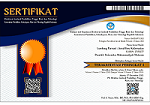Evaluasi Ketepatan Pemberian Antibiotik Empirik Pada Pasien Demam Neutropenia Akibat Kemoterapi Di RSUP Dr Kariadi Semarang
Abstract
ABSTRAK
Demam neutropenia merupakan keadaan yang ditandai dengan suhu dan angka neutrofil meningkat. Neutropenia dapat terjadi akibat kemoterapi dan merupakan keadaan darurat yang dapat mengakibatkan infeksi serius dan harus mendapatkan terapi antibiotik empirik. Penelitian ini bertujuan untuk mengevaluasi ketepatan antibiotik empirik dengan metode gyssens pada pasien kanker yang mengalami demam neutropenia. Penelitian ini menggunakan desain penelitian cross sectional dan diambil secara prospektif di RSUP Dr Kariadi Semarang periode Juli-Oktober 2019. Kriteria inklusi pada penelitian adalah seluruh pasien kanker yang mengalami demam neutropenia dan mendapatkan antibiotik empirik. Data pasien yang diperoleh dari penelitian ini dianalisis dan akan dibandingkan dengan literatur. Hasil penelitian ini mendapatkan sebanyak 101 pasien dengan 57,4% adalah perempuan dan 42,6% laki-laki. Sedangkan untuk jenis kanker yang mengalami demam neutropenia dalam penelitian ini adalah 81,2% pasien kanker non solid dan 18,8% kanker solid. Berdasarkan diagram alir gyssens penggunaan antibiotik empirik pada pasien demam neutropenia yang tepat pada penelitian ini adalah sebesar 74,3% dan tidak tepat sebesar 25,7%.
Kata kunci : Kanker; Kemoterapi; Demam; Neutropenia; Antibiotik.
ABSTRACT
Febrile neutropenia is a state of apprehension with increased temperature and neutrophil count. Neutropenia can occur due to chemotherapy and emergencies that can lead to serious infections and should receive antibiotic therapy. Yhis study aims to achieve antibiotic accuracy with the gyssens method in cancer patients with febrile neutropenia. The study used a cross-sectional study design and was taken prospectively at the Hospital RSUP Dr Kariadi period July-October 2019. The inclusion criteria in the study were all patients who had febrile neutropenia and received empirical antibiotics. Patient data obtained from this study were analyzed and compared with the literature and then performed statistical analysis. The result of the study were 101 patient with 57,4% being female and 42,6% male. Meanwhile, the types of cancer that had febrile neutropenia in this study were 81,2% of non solid cancer patients and 18,8% of solid cancers. Based on the gyssens flow chart the use of empiric antibiotic in patient febrile neutropenia was 74,3% and 25,&% incorrect.
Keyword: Cancer; Chemotheraphy; Febrile; Neutropenia; Antibiotic.
Keywords
Full Text:
PDFReferences
Andreatos, N. et al. (2017) ‘The Dose-Dependent Efficacy of Cefepime in the Empiric Management of Febrile Neutropenia : A Systematic Review and Meta-Analysis’, Open Forum Infectious Disease, pp. 1–10. doi: 10.1093/ofid/ofx113.
Badr, M. et al. (2016) ‘Chemotherapy ‑ induced neutropenia among pediatric cancer patients in Egypt : Risks and consequences’, Molecular and Clinical Oncology, pp. 300–306. doi: 10.3892/mco.2016.957.
Castela, O. D. et al. (2016) ‘Risk Factors for Febrile Neutropenia in Children With Solid Tumors Treated With Cisplatin-based Chemotherapy’, Journal Pediatric Hematology Oncology, 38(3), pp. 191–196.
Erbey, F. et al. (2010) ‘Meropenem Monotherapy as an Empirical Treatment of Febrile Neutropenia in Childhood Cancer Patients’, Asian Pasific Journal of Cancer Prevention, 11, pp. 123–126.
Fernandes, R. et al. (2017) ‘Optimal primary febrile neutropenia prophylaxis for patients receiving docetaxel–cyclophosphamide chemotherapy for breast cancer: a systematic review’, Breast Cancer Research and Treatment. Springer US, 161(1).
Freifeld, A. G. et al. (2011) ‘Clinical practice guideline for the use of antimicrobial agents in neutropenic patients with cancer: 2010 Update by the Infectious Diseases Society of America’, Clinical Infectious Diseases, 52(4).
Han, S. B. et al. (2013) ‘Clinical characteristics and antimicrobial susceptibilities of viridans streptococcal bacteremia during febrile neutropenia in patients with hematologic malignancies : a comparison between adults and children’, BMC Infectious Disease, 13(273), p. 1472334.
Jacob, L. et al. (2014) ‘Clinical and Microbiological profile of Febrile Neutropenia in Solid Tumor and Hematological Malignancies at a Tertiary Cancer care center in South India’, Indian Journal of Cancer, 51(4), pp. 464–468.
Kemenkes RI (2011) ‘Pedoman pelayanan kefarmasian untuk terapi antibiotik’, Kementrian Kesehatan RI., Direktorat Jenderal Bina Kefarmasian dan Alat Kesehatan.
Lyman, G. H. et al. (2010) ‘Risk of Mortality in Patients With Cancer Who Experience Febrile Neutropenia’, American Cancer Society, pp. 5555–5563.
Rasmy, A. et al. (2016) ‘Febrile Neutropenia in Cancer Patient : Epidemiology , Microbiology , Pathophysiology and Management’, Journal of Cancer Prevention and Current Research, 5(3).
Sosa, R. et al. (2017) ‘Use of prophylactic growth factors and antimicrobials in elderly patients with cancer: a review of the Medicare database’, Supportive Care in Cancer. Supportive Care in Cancer, 25(10), pp. 3123–3132.
Zhai, W. et al. (2015) ‘A Prospective Observational Study of Antibiotic Therapy in Febrile Neutropenia Patients with Hematological Malignances from Multiple centers in Northeast China’, International Journal of Infectious Diseases. International Society for Infectious Diseases, 37, pp. 97–103.
DOI: https://doi.org/10.31764/lf.v2i2.5486
Refbacks
- There are currently no refbacks.
EDITORIAL OFFICE:





